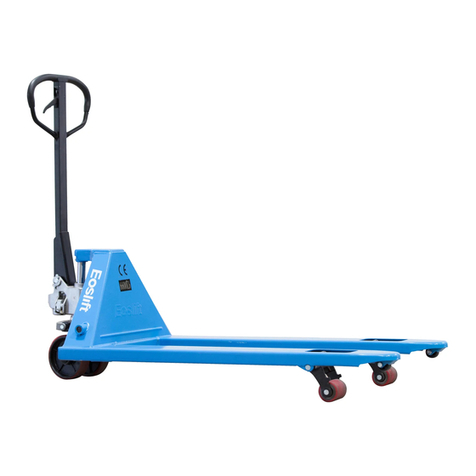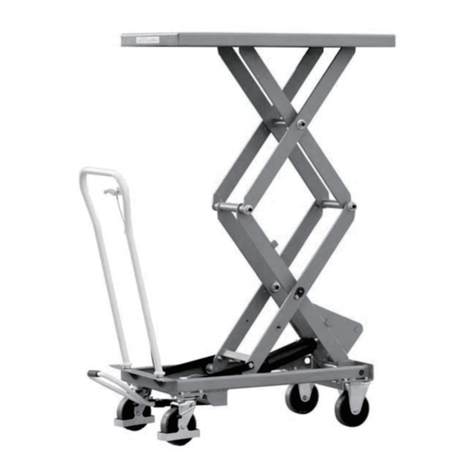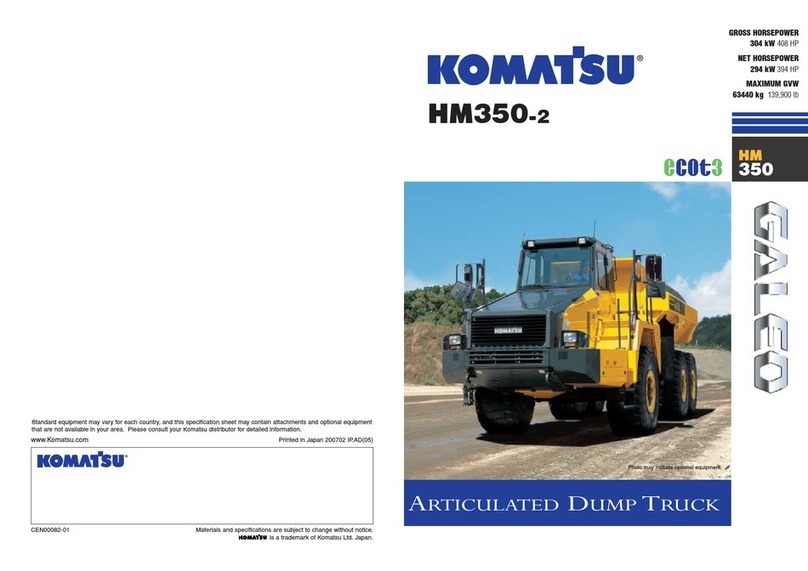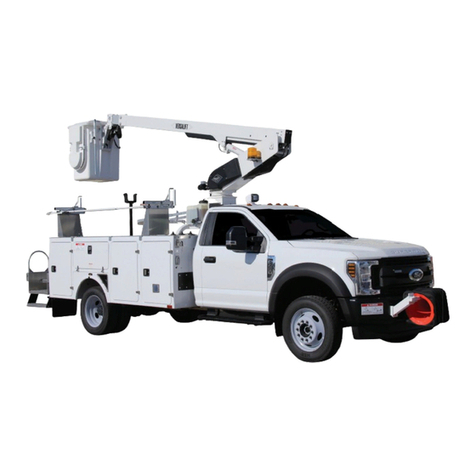Eoslift M25S User manual

Operating Instructions
Hand Pallet Truck
M20S/M25S
BEFORE YOU BEGIN
Thank you for using our pallet truck. Our pallet truck is made of high quality steel and is designed for the lifting
and transport of loads on a pallet or standardized containers on a level, fixed base. For your safety and
correct operation, please carefully read this instruction before using it.
The truck can only operate indoor in an environment without rain and harmful gas erosion. Ambient
temperature for operation:
-20℃~+40℃.
Relative humidity of the environment: less than 90%RH.
Floor Requirements: non slip, hard, level and without holes or obstacles. Ambient Lighting: 50 lux at least.
M20S/M25S
Hand Pallet Truck

1.Technical Specifications
2.1 Remove 3 bolts (111) from the handle bracket (365).
2.2 Set handle (110) on the bracket (365), notice to allow the chain (114) and the adjusting bolts (116)
assembly to pass through the hole in the center of the bracket (365) and shaft (369).
2.3 Insert the 3 bolts (111) through the handle into the bracket (365), then tighten them securely.
2.4 Raise the lever plat (315) and insert the adjusting bolt (116) into the front slot, keeping the adjusting
nut (117) on the under side of the lever plat (315).
2.To Attach Draw-Bar to Pump Unit
(kg)
(mm)
(mm)
(mm)
(mm)
(mm)
(mm)
(mm)
2000 2500
200( or 190 )
85( or 75 )
1150 / 1220
540 / 685
160
Ø 80x70(or Ø 70x70) Nylon, Polyurethane
Ø 200(or Ø 180) Nylon, Polyurethane, Rubber
Capacity
Max. Fork Height
Min. Fork Height
Fork Length
Width Overall Forks
Individual Fork Width
Load Wheel Diameter
Steering Wheel Diameter
M20S M25S
Item/type
3.To Adjust Release Device
On the draw-bar of this pallet truck, you can find the control handle (108) which can be regulated in three
positions :
Raise - handle down
Drive position- handle in center position
Lower - handle up, the lever moves back the drive position when released. If however they have been
changed, you can adjust according to following step:
3.1 If the forks elevate while pumping in the DRIVE position, turn the adjusting nut (117) on the adjusting bolt
(116) or adjusting screw (318) clockwise until pumping action does not raise the forks and the DRIVE position
functions properly.
3.2 If the forks descend while pumping in the DRIVE position, turn the nut (117) or adjusting screw
(318) counter-clockwise until the forks do not lower.
3.3 If the forks do not descent when the control handle (108) is in the LOWER position, turn the nut (117) or
adjusting screw (318) clockwise until raising the control handle (108) lowers the forks. Then check the DRIVE
position according to item 3.1 and 3.2 to be sure the nut (117) or adjusting screw (318) is in the proper
position.
3.4 If the forks do not elevate while pumping in the RAISE position, turn the nut (117) or adjusting screw (318)
counter-clockwise until the forks elevate while pumping in the RAISE position. Then check the LOWER and
DRIVE position according to item 3.1, 3.2 and 3.3.
1
1 Technical Specifications
2 To Attach Draw-Bar to Pump Unit
3 To Adjust Release Device
4 Maintenance
5 Safety Guidance
6 Transportation, Loading, Commission & Storage
7 Trouble Shooting
8 Parts List
Page 1
Page 1
Page 1
Page 2
Page 2
Page 4
Page 5
Page 6
CONTENTS

4.Maintenance
Your pallet truck is largely maintenance-free.
1) OIL
Please check the oil level every six months. The oil capacity is about 0.3lt. Restore the fluid level in the
rubber reservoir to 5mm below the top, this must be with the forks in the lowered position.
Use the hydraulic type oil according to temperature scale below.
Temperature Oil
-20℃~+40℃ L-HV46 Hydraulic oil
2) TO BANISH THE AIR
The air may come into the hydraulic oil because of transportation or pump in upset position. It can cause
that the forks do not elevate while pumping in the RAISE position. The air can been banished in the
following way: let the control handle (108) on the LOWER position, then move the handle (110) up and
down for several times.
3) DAILY CHECK AND MAINTENANCE
Daily check of the pallet truck can limit wear as much as possible. Special attention should be paid to the
wheels, the axles, as thread, rags, etc. It may block the wheels. The forks should be unloaded and lowered
in the lowest position when the job is over.
4) DAILY CHECK AND MAINTENANCE
All bearings and shafts are provided with long-life grease at the factory. You only need provide with long-
life grease at monthly intervals or after each time the truck is cleaned thoroughly to the lubrication points.
5.Safety Guidance
5.15 The truck shall not have direct contact with foodstuffs.
5.16 Do not use the truck on places insufficiently illuminated.
5.17 At others special condition or place, the operator should be careful to operate the pallet truck.
5.1 Operator should read all warning signs and instructions here and on the pallet truck before using this
truck.
5.2 Do not use on a slope.
5.3 Do not operate a pallet truck unless you are familiar with it and have been trained or authorized to do so.
5.4 Do not operate a pallet truck unless you have checked its condition. Give special attention to the wheels
or rollers, the draw-bar unit, the fork unit, the lever plate, etc..
5.5 To pull the truck, always move the control handle into the drive position. This makes the
draw-bar easier to move and depressurizes the pump section of the hydraulics. This preserves the
hydraulic seals and the valve components. A long service life can be expected.
5.6 Do not take up any people on the pallet truck.
5.7 The operator had better take on safety shoes and gloves for labor protecting against crushing and
shearing hazards. Keep feet out from underneath load.
5.8 When the goods have been transported, all people should be away from the forks for 600mm.
5.9 Do not load goods like fig. 5/B. Balance the load securely before moving it.
5.10 Do not load over maximum capacity.
5.11 Do not use the truck when traveling on lorries.
5.12 Do not use the truck in a potentially explosive atmosphere.
5.13 Do not use the truck as a vehicle jack.
5.14 Do not use under wind forces.
Fig. 4
Fig. 5
2
3

6.Transportation, Loading, Commission& Storage
If the truck has to be transported for a long distance, it should be packed in the container in order to avoid
collision during transportation.
6.1 See fig. 6. It should detach hand grip before hoisting and transporting the product.
6.2 The hand grip should be fixed stably in case gliding and damages. And then they are packed in a case
and transported by fork truck or hoisting apparatus.
6.3 Before loading, the operator shall make sure the truck weight on the nameplate to choose the
suitable hoisting equipment. When the truck is unloaded, the operator shall look out for safety around to
ensure slow landing of the truck.
6.4 If the truck is transported with the forklift truck, the forklift shall lift slowly to keep the balance of the
truck, and then put it down on the ground.
6.5 On completion of commissioning, the truck shall be submitted to and verified according to the
following function test: steering, traveling, braking, load handling controls and combined functions with
rated capacity.
6.6 When a truck is inoperative, the load (if applicable) shall be removed with a proper tool and measure,
the truck shall be transported out of the working zone with a proper way.
6.7 When the truck will be shutdown and in storage for a long time, the storage environment shall be kept
dry and clean, fork shall be lowered to its lowest position.
4
5
Fig. 6
7.Trouble Shooting
NOTE: DO NOT ATTEMP TO REPAIR THE PALLET TRUCK UNLESS YOU ARE TRAINED
AND AUTHORIZED TO DO SO.
No Trouble Clause Fixing Methods
1
2
3
4
5
The forks can
not be up the
max. height.
- The hydraulic oil is not enough. - Pour in the oil.
- Fill in the oil.
- Change the oil.
- Adjust the nut(104) or screw
(318) (see item 3.4)
- Banish the air.(see item 4.2)
- Without hydraulic oil.
- The oil has impurities.
- The nut (104) is too high, keep the
pumping valve open.
- Air come into the hydraulic oil.
The forks can
not be lifted
up.
The forks
can not be
descended.
- The piston rod (344) or pump (328) is
deformed resulting from partial loading
slanting to one side or over-loading.
- The fork was kept in the high position
for long time with piston rod bared to
arise in rusting and jamming of the rod.
- The adjusting nut (104) or screw (318)
is not in correct position.
- Replace the piston rod (344)
or pump (328).
- Keeping the fork in the lowest
position if not using, and pay
more attention to lubricate the rod.
- Adjust the nut (104) or screw
(318) (see item 3.3)
Leaks
The fork
descends
without the
release valve
worked.
- Sealing parts worn or damaged.
- Some part cracked or worn into small.
- Replace with the new one.
- Replace with the new one.
- The impurities in the oil cause the
release valve to be unable to close tight.
- Some parts of hydraulic system is
cracked or bored.
- Air comes into the oil.
- Sealing parts worn or damaged.
- The adjusting nut (104) or screw (318)
is not in the correct position.
- Replace with new oil.
- Inspect and replace the waste parts.
- Banish the air. (See item 4.2)
- Replace with the new one.
- Adjusting the nut (104) or
screw (318). (See item 3.2)

6
7
8.Parts List
This manual suits for next models
1
Table of contents
Other Eoslift Truck manuals























